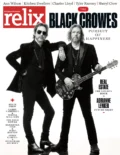DB: This was the birth of The Rockett Band, who for several years was the Sunday night house band at the renowned and much-missed Boston blues bar Harper’s Ferry. How did you get that gig?
DR: I lived in a house in Allston (a neighborhood of Boston) with a bunch of musicians from different bands. Andrew Stahl, who ran (local music production company) Gamelan Productions, ran the whole Boston jamband scene and worked out of that house. Susan Tedeschi had been the Sunday night performer at Harper’s Ferry but left to do a tour. At Andrew’s suggestion, we auditioned to replace her. They tried out a few other bands, but we got the gig. It turned into something really cool we did from 1995 to ’99.
DB: In 1997, the Rockett Band released its first CD, Harmony’s Window. How did that come about?
DR: I had plenty of songs stockpiled so there was plenty of material. My brother lent me the money to pay for a studio and we self-produced the album. We mostly toured New England with it, but also New York, Colorado and Utah. For a while we had a weekly gig at the Lion’s Den in Greenwich Village, which was very cool.
DB: Did you ever open for anyone famous?
DR: Never on an entire leg of a tour, but we did some one-offs with performers like Ziggy Marley and Los Lobos.
DB: Why did you decide to end the Rockett Band in 1999 and move to Los Angeles?
DR: Nothing against the other guys, but I felt we had kind of done our thing and wanted to move on and try other stuff. My element in the Rockett Band was so in place as lead vocalist and rhythm guitarist that the other guys had time to improvise while I was engrossed in orchestrating the music. I wanted to be involved in jamming more and become more proficient at guitar. It was a natural thing, though I don’t think everyone else saw it that way at the time (laughs).
DB: How did you wind up leaving Boston to go to Los Angeles?
DR: My friend from college Ben Gordon got a job at Interscope Records after graduating and kept checking in on me. He had been interested in the Rockett Band while at Interscope and flew to Boston a few times to check us out. He and Ian Montone, the manager of the White Stripes, funded my solo album What I’ve Seen, which I recorded with different musicians around Boston after the Rockett Band. They believed in me quite a bit.
What really got me to move to L.A., though, was that I was sick of February and March on the East Coast (laughs). If I had to spend one more winter there I was worried I might commit mass homicide.
DB: What happened when you got to L.A.?
DR: I met Dorian 27, who had just left Powerman 5000 as bass player, and we hung out. I realized I’d need a band to play songs. I got Les Hall, who went on to play with the Trey Anastasio Band, on guitar. We went through a bunch of drummers and I got sick of looking for drummers, so Dorian switched. We wound up getting Wes Wehmiller, who played bass with Duran Duran and Missing Persons, to take his place, but unfortunately he passed away a few weeks before we were supposed to start recording an album.
I still had a demo of new songs and Ben asked me if I could have any producer in the world work on it, who would it be. I said Bob Ezrin (producer of The Wall ). Ben sent it to him and a few weeks later the phone rang and a voice said, “This is Bob Ezrin and I just listened to your demo and I loved it.”
The next week, he was sitting in my apartment across from me while I was playing him my tunes. I worked with Bob for three months, and he helped shape me as a songwriter by ripping my songs apart, but in an amazing way. He never told me what to do, but he’d point out things like a part of a song wasn’t working so great and maybe something else could go there instead. He was also working on the Jane’s Addiction Strays album and eventually had to devote more time to that project, but the time I spent with him was life-changing.


No Comments comments associated with this post